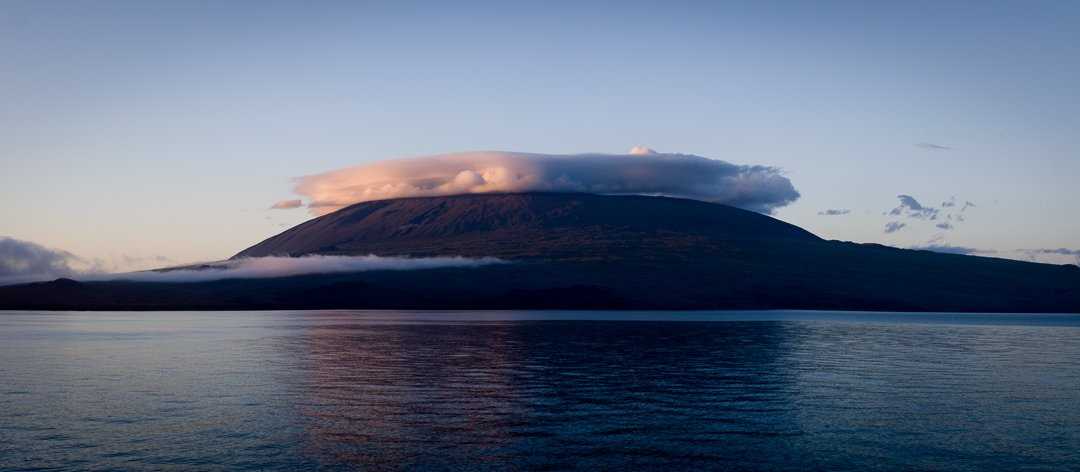As the National Geographic Islander rounded Cape Albemarle having just crossed the equator a few minutes before, the eastern sky started to reveal an orange tinge announcing that sunrise was imminent.
Cape Albermarle is the most northern point of Isabela Island and just south of it lies an enormous sleeping giant. Volcan Wolf is the tallest of the five active volcanoes that make up the “seahorse” shaped island of Isabela and its summit at 1727 meters above sea level is the highest point in the Galapagos archipelago.
This morning a thick “lenticular” (lens shaped) cloud covers the “table top” summit of Wolf, but the sky above us and the visibility are perfect and we have set ourselves on a mission to scout for whales and dolphins as we pass this gateway to the western end of these enchanted isles.
Getting up and about so early paid off, as it wasn’t long before the first spout was spotted in the distance. As we approached it became evident that a small group of baleen whales was already busy foraging as individual whales would arch their backs and disappear into shallow dives for a few minutes at a time. In total we estimated the group contained between two and four Tropical Rorquals (also known as Bryde’s whales) and at least one blue whale.
We had breakfast right after the ship’s horn was sounded, celebrating our return to the southern hemisphere. Right after breakfast we laid anchor at the foot of the extinct Volcan Ecuador and we set off for a coastal exploration aboard our Zodiacs of this area formally known as Punta Vicente Roca. The area was teeming with activity as groups of blue footed boobies furiously “plunge dived” over and over again after fish. The Galapagos penguins seemed to be in hunting mode as well and right at the moment when we had decided to turn back to the ship a massive male Orca whale surfaced only a few hundred feet away and allowed us to have a closer look at him.
We eventually managed to say goodbye to the magnificent whale and went back to the ship where after a quick turnaround we set off for a snorkeling session. We got to see quite a few new species of fish, but the hunting Galapagos penguins and the sheer number of Pacific green sea turtles, which come to this place to forage and rest, were the absolute highlight.
After having sailed toward Fernandina Island during lunch, we disembarked for a last excursion at the only visitor site on this island, an area known as Punta Espinoza. Here we had a chance to explore the smooth Pahoe-hoe lava flows that make up this rocky outcrop. The chances to have a closer look at the Galapagos flightless cormorants and the numerous aggregations of marine iguanas were excellent.
We returned back on board just as the sun was beginning to dip behind the point. This turned out to be an amazing day with one surprise after aother from sunrise to sunset!









